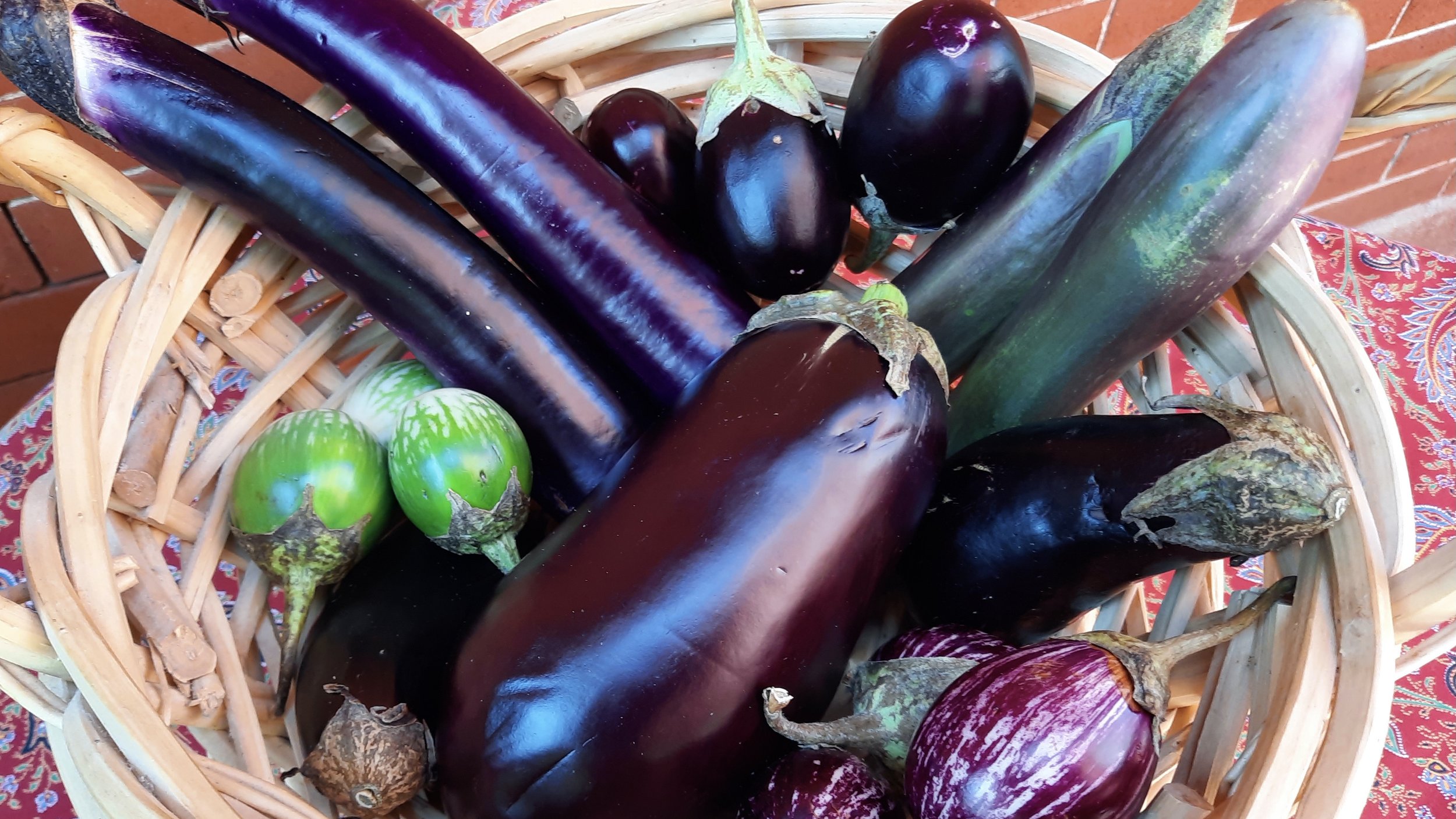THE EGGPLANT
A recipe for Indian Mashed Curried Eggplant (Baigan Bharta) follows the story below on The Eggplant.
An array of various eggplants from around the world.
Like the tomato, to which it is related botanically, the eggplant (Solanum melongena) is a fruit, not a vegetable, though we consider it and cook it as the latter.
Unlike the tomato, however, a food that typically adds flavors to other cooked foods, the eggplant is marvelous in how it takes on flavors. It is one of cooking’s great canvases. It is mild in flavor and has been constructed by nature to be little more than a sponge. It is set up to do its job from the get-go.
Around the world, the eggplant is roasted, grilled, baked, braised, pan-fried, deep-fried, smoked and stewed. Turks brag that they have 40 ways to cook eggplant; it is ubiquitous in the cooking of both the Near and Middle East. There is no ratatouille without eggplant, no Sicilian caponata, no baba ghanoush.
Greeks make moussaka of it; the Italians are famous for their “melanzane parmigiana,” which we Americans of whatever background have taken to with alacrity.
You can readily see how it gets its name from the eggplant commonly available in our grocery stores: it’s a big, purple-black “egg,” capped with a green beanie. (If you ever encounter a white eggplant, you’ll clearly see its ovoid character.) Smaller versions of the same are called Italian eggplants; they resemble purple-black truncheons.
Chinese and Japanese eggplants are much more elongated than these two but similarly colored, with Chinese eggplants sometimes approaching lavender in hue. Thai eggplants are smallish and green-striped; Indian, small again, striped and reddish-purple. Philippine eggplants are medium-long and greenish-purple. There are other eggplants, with other colors and other shapes, from other places.
All cook up much the same, although each has it special place; the Thai eggplant, for example, being one of the only that’s easily eaten raw.
Their common issue in the kitchen is how their innate nature soaks up its cooking medium, most often oil, making for a fatty-tasting, often greasy finish to the food.
You often will read, in a given recipe, to “sprinkle salt on the pieces of eggplant and let them drain in a colander in the sink.” The reason given—“to remove bitterness”—is merely a small portion of the truth. (Much more bitterness is transformed into a sort of sweetness, the caramelization of the Maillard Reaction, by the application of heat later in the recipe.)
The important thing that you do in the salting step is to remove the eggplant’s generous moisture and begin to weaken and collapse the cell walls of the eggplant’s sponge-like construction. Further removal of moisture (say, by roasting the eggplant in high heat or microwaving the slices or cubes between paper towels) allows for even more development of caramelization later in the recipe. Without doing that, the eggplant “steams away” any chance at coloring nicely.
Few “brown” foods taste—or feel, with its pillowy texture—as delicious as a piece of well-tanned eggplant.
The recipe here is a classic Indian treatment of eggplant, the fruit (OK, “vegetable”) taking up the many aromas and savory notes that mark the Indian pantry.
Mashed Curried Eggplant (Baigan Bharta)
Mashed Curried Eggplant (Baigan Bharta)
Adapted from “Indian for Everyone,” by Anupy Singla (Surrey Books, 2014). For the garlic and ginger as listed, you may substitute 6 heaping tablespoons ginger-garlic paste, readily available at Indian and some Asian grocers. Makes 5 cups.
Ingredients
1 large globe-shaped purple-black “American” eggplant
2 purple “Asian” eggplants, each 10-12 inches long
1 large yellow onion, unpeeled to begin
2 tablespoons neutral vegetable oil or ghee
1 teaspoon cumin seeds
1 teaspoon ground coriander
1 teaspoon ground turmeric
1 2-inch piece fresh ginger, peeled and grated
8 cloves garlic, peeled and grated
2 medium tomatoes, peeled and diced (whole peeled canned OK)
2 medium Pueblo chiles, charred, peeled, veined and seeded, chopped
1/2 teaspoon red chile powder
1 teaspoon salt
Naan
Directions
Line a large baking sheet with parchment paper and heat oven to 400 degrees. Prick the eggplants in several places with sharp tines of pork or the point of a knife (to allow steam to escape and prevent bursting). Place the eggplants and the whole onion on the baking sheet and cook for 40 minutes, or until the larger eggplant begins to markedly “deflate.”
Remove from oven and let cool enough to handle, 15-20 minutes. Slit the eggplants longways and scrape out the flesh off the skin with a wooden spatula or spoon. Coarsely chop the eggplant flesh and reserve. Peel the onion and dice it.
In a large saucepan, over medium-high heat, warm the oil or ghee and in it cook the cumin seeds for 40 seconds, until they sizzle and become aromatic. Add the coriander and turmeric, stirring, and heat for 30 seconds. Add the diced onions, stir well, cover the pan, lower the heat a bit and cook the onions for 10-15 minutes, until they soften even more and begin to brown.
Uncover the pot, raise the heat to medium-high and stir in the grated garlic and ginger (or 6 heaping tablespoons ginger-garlic paste) and cook for 2 minutes, blending well. Add the tomatoes and chopped chiles, stir to blend and cook for 4-5 minutes, scraping the bottom of the pot so nothing sticks.
Add the reserved eggplant flesh, the red chile powder and the salt, blend well and cook for 5-6 minutes, stirring, again so nothing sticks.
Remove the pot from the heat and let cool a bit. Using a potato masher, mash the eggplant mixture well, retaining some chunks in a texture to your liking.
Serve warm or at room temperature with warmed or toasted naan.

